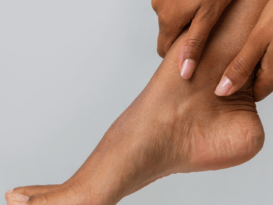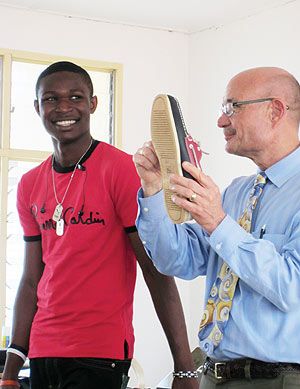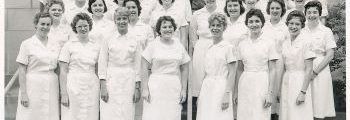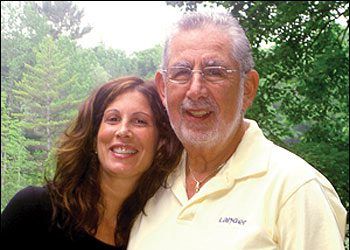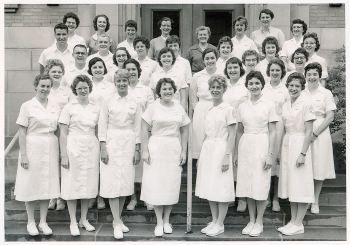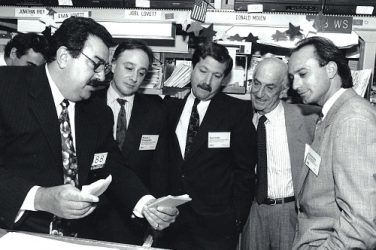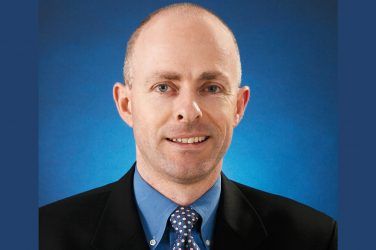Dennis Janisse, CPed, is one of the most recognized names in the U.S. pedorthics profession. He has been involved in the profession for four decades and has been working on its professional committees and councils since the 1990s. Despite his perennial willingness to serve, he has also built a well-known pedorthic business, National Pedorthic Services (NPS), which now operates two locations in greater Milwaukee and another in Madison, Wisconsin, and is widely regarded for the range and quality of its shoe and orthotic work.
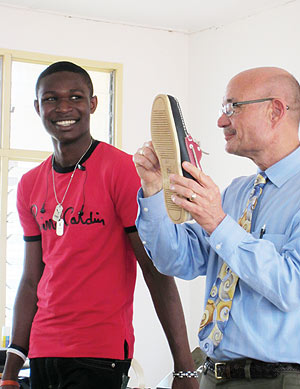
Janisse teaches the importance of footwear to protect at-risk feet on a trip to Ghana. Photographs courtesy of Dennis Janisse.
Early Years
Janisse was born in Madison, WI and spent his childhood years in Milwaukee. When he was six years old he contracted rheumatic fever and spent almost two years at home, essentially alone. To amuse himself he read, but he also liked to take things apart and reassemble them – perhaps a harbinger of his future career.
Janisse moved with his family to the smaller town of Grafton, Wisconsin, while he was still a child, where his father, an engineer who had been in the Navy toward the end of World War II, went to work as an engineer for Milwaukee-based Johnson Controls. His mother was the first female unionized meat cutter in Wisconsin. She worked in a supermarket where she was expected to wear high heels and, according to Janisse, developed foot problems as a result. Janisse says that his parents were hard working, believed in fiscal responsibility, and instilled a strong work ethic in him. “Whatever you do, do the very best you can,” was advice he says he often heard from his mother.
As a teenager Janisse held various part-time jobs including being a projectionist for a local movie theatre, working on a mink ranch, and assisting at a local dry cleaning business. The dry cleaning business was a small, family-owned operation, and Janisse says he enjoyed working there. Despite his parents’ encouragement to go to college, he chose instead to attend dry cleaning school in Silver Spring, Maryland. He saved his money to pay for tuition and travel expenses to Maryland and spent three months learning about the care and maintenance of clothing. Janisse says that was the first time he saw how acquiring education can make a big difference to a person’s chosen profession He did well at the school and won a scholarship to return and complete a three-month business course.
At 21, Janisse got a job in Milwaukee working for a couple who owned a central dry cleaning plant with several satellite stores. It was there, he says, that he learned customer care and the importance of service. Over the next few years he continued to learn the business and began to manage the operation. Janisse says he knew he wanted to have his own business, but at the time, the early 1970s, the dry cleaning industry was going through a major overhaul. Standards of dress shifted, and with the emergence of new synthetic fabrics, wash-and-wear clothing options were becoming more common, thus decreasing the need for dry cleaning services. Janisse’s employers responded to the changing consumer demand by taking in shoe repair work as a secondary income stream to sustain their business. The stores accepted jobs from customers, and a shoe repairman who Janisse befriended did the work. Interestingly, changing industry expectations have been a theme within Janisse’s career life, one that we are seeing repeated today in healthcare.
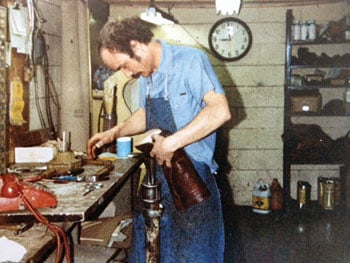
Janisse repairs shoes in his early career days.
Entrepreneur and Pedorthist
During that time, Janisse married, and he and his wife, Beth, who was a skilled seamstress, decided they would buy a shoe repair store from his shoe repairman friend and mentor. In 1972 they purchased the man’s West Bend, Wisconsin, shop for $3,000, with Janisse’s father offering his stock certificates as part of their loan collateral. Originally called Dennis’ Shoe Repair, this was the first location for the company that would eventually become NPS. Over time the cobbler taught Janisse everything except how to machine-stitch outsoles – a difficult skill to learn. Janisse recalls that to help him learn, Beth decided to get worn shoes from relatives and make him practice resoling them all night until finally, by morning, he was confident with the task. As they built the business and raised three children, Janisse says they put in long hours. To balance career and family life, he would leave very early in the morning in order to be able to spend time with the children in the evening.
As the business grew, Janisse found that he was doing more orthopedic work, putting lifts and wedges onto shoes, and he began to carry a line of corrective shoes for children. Through the corrective shoe market, he says he became aware of a course offered in Colorado Springs, Colorado, hosted by the Pedorthic Footwear Association (PFA, now known as the Pedorthic Footcare Association) and decided he would attend the class to broaden his understanding. Janisse remembers the program instructor Seymour Lefton as being very helpful, encouraging him to go to Ball State University, Muncie, Indiana, and become a certified pedorthist. Meanwhile, the local physicians and referral sources for Janisse’s business were also encouraging him to become certified so that they could refer pedorthic work to him. Beth joined Janisse in gaining pedorthic education; she completed the course and passed her exam before he did. He followed and earned his Board for Certification in Pedorthics (BCP) certification in 1984. (Editor’s note: BCP integrated with the American Board for Certification in Orthotics and Prosthetics in 2007, thus becoming the American Board for Certification in Orthotics, Prosthetics and Pedorthics (ABC).)
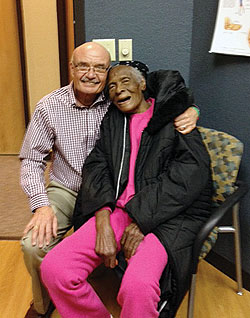
Janisse with a 99-year-old patient.
The Janisses rented the adjacent shop space and converted it into their pedorthic center to continue to expand their business. The local physicians were supportive of their progress; one day they received a referral for their first patient with diabetes. Janisse says that with a mix of nervousness and determination, and a little coaching over the phone from Lefton, he faced the challenge and was able to help the patient. Now, many years later, he has become one of the most knowledgeable practitioners in pedorthic interventions for patients with diabetes. Janisse recalls the helpful attitude within the profession and he appreciates what his mentors did for him – an appreciation that is expressed in his own altruistic nature and willingness to help others in the profession.
The business in West Bend grew, and there was a steady stream of referrals from podiatrists and orthopedists. He attended his first national PFA meeting in New York, New York. As he began to promote his business in the larger Milwaukee market, patients travelled from an increasing distance for appointments; some of those patients from the 1980s are still his patients today. Constantly seeking opportunities, he moved to larger premises and tried other lines, such as Western boots, extra-depth shoes, and an expanded line of children’s footwear. Not all of his endeavors met with success, however. Janisse cites one such example when he bought a shoe shop in another small town and soon learned that retail shoes are an entirely different business model; they closed the location within four years.
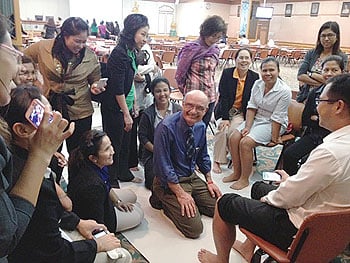
Janisse shares his knowledge in Thailand on one of his many trips.
Recognizing that most of his referral base was in Milwaukee, Janisse opened a second, “strictly pedorthic,” office there. That began as a satellite but eventually emerged as NPS’ main location. A third location joined the first two, in the city’s South Side neighborhood. The business prospered, and Janisse shifted focus from shoe repair; in time he closed the original West Bend shop. NPS was building a strong reputation due to the care and quality of work its employees offered, and it expanded into other markets. At different times in its history, NPS had locations in Rochester, New York; Houston, Texas; Chicago, Illinois; Indianapolis, Indiana; and St. Louis, Missouri. Janisse continued to learn and attend clinics at medical colleges and became an honorary member of the prestigious American Orthopaedic Foot & Ankle Society (AOFAS). Within the pedorthic profession he has consulted for PW Minor, headquartered in Batavia, New York, and more recently for Orthofeet, Northvale, New Jersey.
Service
Janisse is known in the profession as a man of service, and he has taken on many roles within it. He joined PFA in 1984 and was president of the PFA Research Foundation from 1988 to 1994. This is now the Pedorthic Foundation, and he still sits on its board. He served as president of PFA from 1993 to 1995. In that time he helped write the seminal Medicare Therapeutic Shoe Bill, which is designed to prevent diabetes-related foot ulcers and complications by allowing Medicare beneficiaries with diabetes to get specialized footwear and foot orthotics. This ultimately contributed to the lower rates of distal foot amputations that we are seeing today. For the past eight years he has been the pedorthic member of the ABC board. He is chairman of the American Orthotic & Prosthetic Association (AOPA) pedorthic education committee, and he has developed the pedorthic education program for the PrimeCare Orthotics & Prosthetics Network’s PrimeFare symposiums. Over the years he has written and published numerous articles and academic book chapters on foot health; spoken at countless conferences and colleges; and sat on a host of other committees and advisory boards, all with the aim of heralding the importance of pedorthics. He has travelled extensively to promote this message and even found time to participate in a mission to West Africa, with the Legs to Stand On nonprofit organization, to help teach local citizens to make inexpensive sandals to protect at-risk feet.
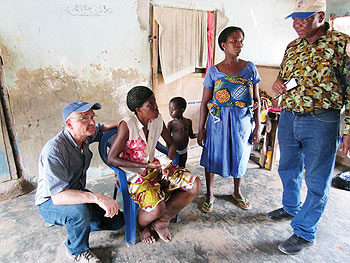
Janisse visits with locals in Mali.
Managing and staffing multiple NPS locations whilst safeguarding quality and reputation proved to be a big challenge. Navigating the constant shifts in healthcare and insurance reimbursement also forced changes in NPS’ business model. The company now has two patient locations and a main fabrication laboratory that also serves as the corporate headquarters. Both of Janisse’s sons, Erick, CO, CPed, and Jeremy, CPed, COA, have joined the family business and various side ventures, and his daughter-in-law Nicole runs the operation. While he still accepts Medicare, he has developed more self-pay client relationships, filling their prescriptions but requiring payment. His policy now is to do excellent work as well as to provide his patients with all of the information they need to submit their own reimbursement claims. He says he believes in showing patients the benefits of pedorthics, educating them, and demonstrating real value.
Not one to complain, Janisse has proven skillful at navigating evolving conditions and making the best of what is presented. Over a long and distinguished career he has remained engaged and adaptable. Janisse says he has always loved the contact with patients and physicians. He says he really wants to “make a difference in people’s lives” – to give patients a better quality of life. Janisse says one of his other tenets is that practitioners should strive to learn, educate themselves, teach others, and run good businesses that help communities. One of his many talks ends with the phrase, “Decrease foot complications, decrease amputations, enhance life all over the world,” which is truly a fitting byline for the continuing career of Dennis Janisse.
Séamus Kennedy, BEng (Mech), CPed, is president and co-owner of Hersco Ortho Labs, New York. He can be contacted via e-mail at seamus@hersco.com or by visiting www.hersco.com.
